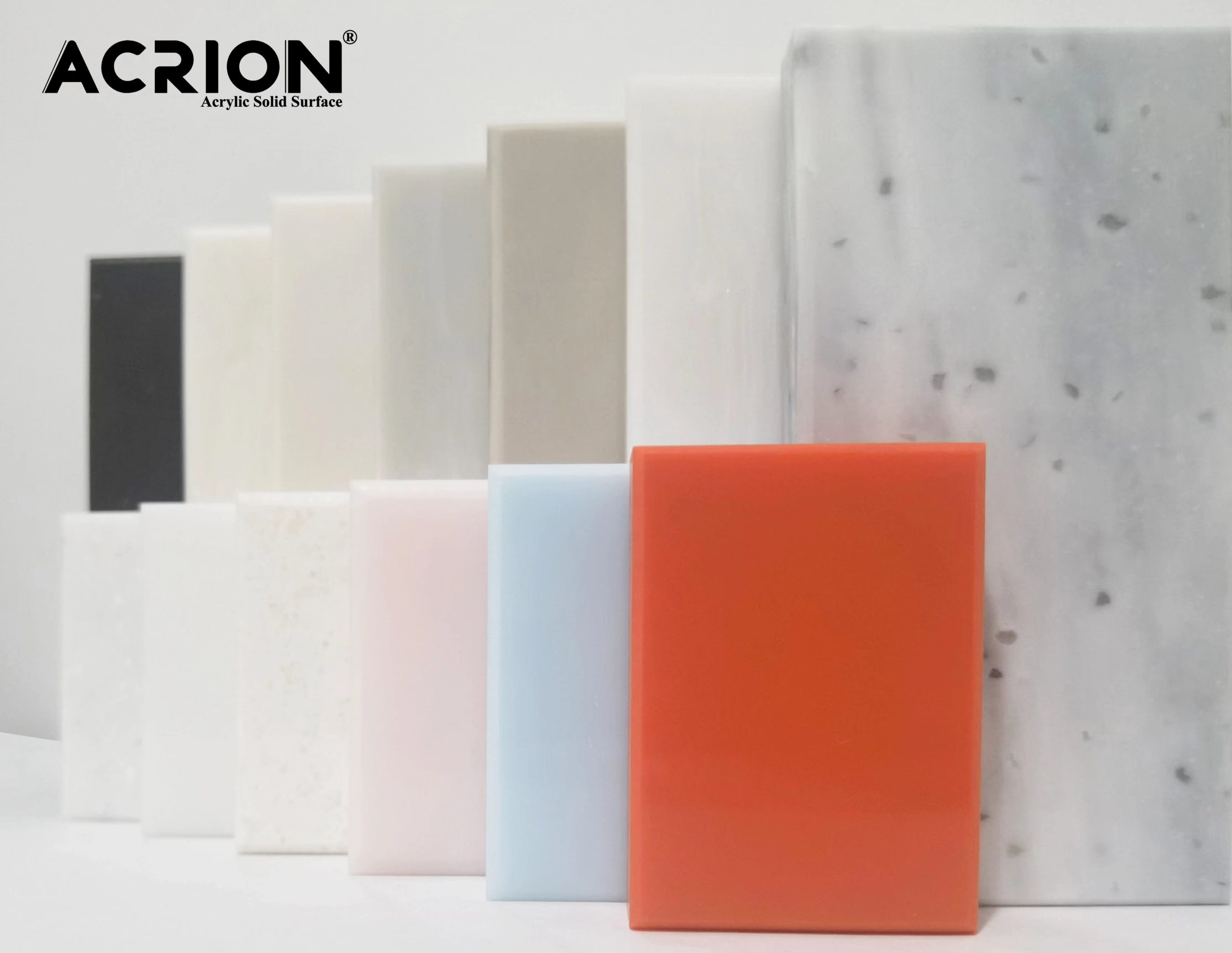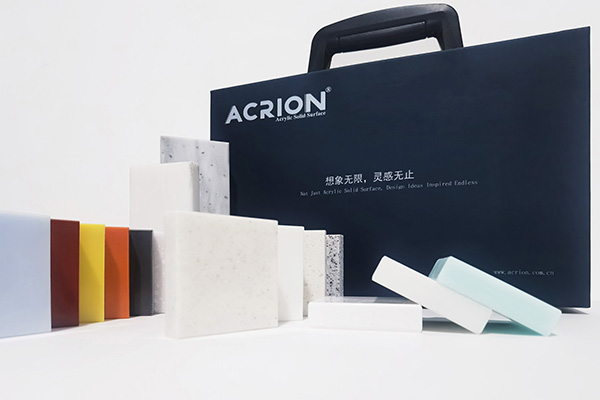アクリル固体表面の低温抵抗性能の分析は、材料構造、機械的応答、環境相互作用の3つの次元から実行する必要があります。包括的な評価は、実験室テストと実際のアプリケーションシナリオと組み合わせて実施する必要があります。次の分析は、3つの側面から実行されます。キーパフォーマンスインジケーター、テスト方法、障害メカニズム:
まず、低温環境での物理的特性の変化
ガラス遷移温度(TG)の影響
アクリル樹脂のTgは通常、0〜50°の間です。周囲温度がTGよりも低い場合、コーティングは非常に弾力性のある状態からガラス状態に変化し、分子鎖の動き能力は大幅に低下します。たとえば、Tgの10°のコーティングは、-10°の環境で柔軟性が50%以上低下し、耐衝撃性の低下をもたらす可能性があります。
低温の腹部現象
脆性骨折は、-30°〜 -50の範囲内のコーティングで発生する可能性があります。 Notch Impactテストでは、室温での延性骨折を伴うコーティングが低温で脆性骨折に変化することが観察でき、断面は鏡のような特徴を示し、亀裂伝播エネルギーが大幅に減少することを示しています。
収縮ストレスの蓄積
低温により、コーティングの体積が収縮します。熱膨張係数が基質のそれと一致しない場合、界面応力を引き起こす可能性があります。たとえば、コーティングと金属基質の収縮率の差は、-20℃で0.5%に達する可能性があり、接着またはコーティング亀裂が減少します。
第二に、低温性能のテスト方法
低温腹部温度テスト
GB/T 5470-2008標準に従って、コーティングサンプルを液体窒素で冷却し、2℃/分の速度で冷却したコーティングサンプルをフィクスチャに配置しました。コーティングが壊れた温度が記録されました。典型的なアクリルコーティングの腹部温度は、-40℃と-60℃の間です。この温度以下では、コーティングは壊滅的な損傷を受けやすいです。
低温曲げテスト
コーティングされたサンプルを-20℃、-40℃、-60℃に2時間保持した後、すぐに180°の曲げテストを実施します。コーティングの表面に亀裂があるか、剥がれるかを観察します。たとえば、曲げ半径が-40℃で5mm未満の場合、コーティングは0.1mmレベルでマイクロクラックを発生させる可能性があります。
低温接着試験
設定温度で30分間維持された後、グリッド法によって接着を評価しました。たとえば、室温でグレード0の接着グレード0のコーティングは、-30℃でグレード2に低下する可能性があり、低温が界面結合力の弱体化につながることを示しています。
低温サイクリングテスト
昼と夜の温度差をシミュレートするために、コーティングサンプルは、-40°から20°の範囲内で100の冷たいサイクルとホットサイクルにさらされ、各サイクルは2時間続きました。コーティングが粉末、泡立ち、剥離を示すかどうかを観察し、その長期の気象抵抗を評価します。
第三に、低温環境での障害メカニズム
内部ストレスによって引き起こされる亀裂
低温収縮は、コーティング内に引張応力を引き起こします。応力がコーティングの引張強度を超えると、表面に垂直な亀裂を引き起こす可能性があります。たとえば、100μmの厚さのコーティングは、-50の幅0.2mm幅の放射状亀裂を生成する可能性があります。
インターフェイスの剥離
コーティングと基質の間の接着が不十分な場合、低温収縮は界面の剥離を引き起こす可能性があります。 -30で処理されたコーティングの断面が明らかな層間層分離を示し、界面の残基が減少することがSEMを通じて観察できます。
微小酵素分離が強化されます
低温では、アクリル樹脂の柔らかいセグメントとハードセグメント間の互換性が減少し、微小酵素分離につながる可能性があります。たとえば、TGに有意差を持つ共重合体は、-20°Cの5-10μmレベルで位相分離構造を示す可能性があり、コーティングの均一性に影響します。
第4に、実際のアプリケーションシナリオの検証
非常に寒い地域の建物の外壁
-40の環境では、凍結融解サイクルに対するコーティングの抵抗を検証する必要があります。たとえば、コーティングされたサンプルを水に浸し、-40℃で凍結し、溶けるために20℃に移します。これを50回繰り返し、コーティングが剥がれているかどうかを観察します。
コールドチェーン輸送機器
-25°から-18の範囲のコールドストレージ環境の場合、低温および高湿度条件下でのコーティングの腐食抵抗をテストする必要があります。たとえば、白い霜や錆が表面に現れるかどうかにかかわらず、コーティングが72時間で-20℃と90%RHに維持された後。
極地のコーティング
-60℃の極端に寒い条件下では、コーティングの耐衝撃性を評価する必要があります。たとえば、ドロップハンマーインパクトテストが採用されました。コーティングは、1Jのエネルギーで-60℃で影響を受け、可視亀裂が発生したかどうかを記録しました。
5番目、パフォーマンス最適化の方向
分子構造設計
柔軟なセグメント(アクリル酸ブチルなど)の導入は、TGを減らし、低温靭性を改善することができます。 For instance, copolymerizing ethyl acrylate with butyl acrylate can reduce the Tg from 20℃ to -10℃, significantly improving the low-temperature performance.
架橋密度調節
中程度の架橋はコーティングの強度を高めることができますが、過度の架橋は柔軟性を低下させます。たとえば、架橋剤の投与量を調整することにより、硬度を維持しながら、低温の腹部の温度を10°減らすことができます。
フィラーの変更
ナノスケールフィラー(発煙シリカなど)を追加すると、亀裂伝播を阻害できます。たとえば、5%のナノフィラーを追加すると、-40)でコーティングの破損時の伸長が20%増加する可能性があります。



